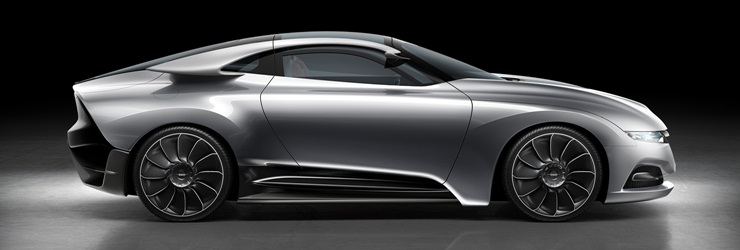Saab PhoeniX sports coupe concept showcases the future of Saab
07 Mar 2011|4,598 views
 |
The PhoeniX was designed by Saab's new design chief, Jason Castriota, and the Swedish carmaker says that the PhoeniX features an "Aeromotional" design, which the company describes as the "the visual evocation of the aerodynamic design principles".
Among the aircraft-inspired design details include the rear lateral winglets and the fighter-jet style glasshouse canopy. The twin-ripple bonnet gives it an aggressive stance, while the LED 'ice-block' headlights and distinctive reinterpretation of the Saab grille is expected to feature on future Saab models.
According to Castriota, "The PhoeniX establishes a new reference point for the future of Saab product design. It symbolizes a renaissance of the innovative spirit and passion that drove Saab to build its first car. We're now taking the visual DNA forward with what we call 'Aeromotional' design, adding emotion, power and fluidity."
Saab did not reveal pictures of the PhoeniX's interior, but says that it will have a minimalist design, with a 2+2 seating arrangement and an afterburner-inspired instrument cluster. More importantly, there is an Android-based IQon infotainment system which manages audio and entertainment streaming, online navigation, on-board music storage and downloading of applications.
The PhoeniX concept is powered by a 1.6-litre turbocharged petrol engine that produces 197bhp and 250Nm of torque which are sent to the front wheels, and is combined with an electric motor at the rear axle, called eXWD, that produces an additional 34bhp, giving the PhoeniX a unique four-wheel-drive system. The electric motor is powered by a small battery pack and uses regenerative braking to keep it charged. All told, the Saab PhoeniX concept is able to go from 0-100km/h in 5.9 seconds, and reach a top speed of 250km/h.
There are three modes for the PhoeniX's eXWD system, Eco, Sport and Traction. The first is set by default and delivers optimal fuel and CO2 efficiency, the second includes maximum power assistance with torque vectoring across the rear-axle and the third enables optimal grip in slippery conditions and at take-off.
 |
The PhoeniX was designed by Saab's new design chief, Jason Castriota, and the Swedish carmaker says that the PhoeniX features an "Aeromotional" design, which the company describes as the "the visual evocation of the aerodynamic design principles".
Among the aircraft-inspired design details include the rear lateral winglets and the fighter-jet style glasshouse canopy. The twin-ripple bonnet gives it an aggressive stance, while the LED 'ice-block' headlights and distinctive reinterpretation of the Saab grille is expected to feature on future Saab models.
According to Castriota, "The PhoeniX establishes a new reference point for the future of Saab product design. It symbolizes a renaissance of the innovative spirit and passion that drove Saab to build its first car. We're now taking the visual DNA forward with what we call 'Aeromotional' design, adding emotion, power and fluidity."
Saab did not reveal pictures of the PhoeniX's interior, but says that it will have a minimalist design, with a 2+2 seating arrangement and an afterburner-inspired instrument cluster. More importantly, there is an Android-based IQon infotainment system which manages audio and entertainment streaming, online navigation, on-board music storage and downloading of applications.
The PhoeniX concept is powered by a 1.6-litre turbocharged petrol engine that produces 197bhp and 250Nm of torque which are sent to the front wheels, and is combined with an electric motor at the rear axle, called eXWD, that produces an additional 34bhp, giving the PhoeniX a unique four-wheel-drive system. The electric motor is powered by a small battery pack and uses regenerative braking to keep it charged. All told, the Saab PhoeniX concept is able to go from 0-100km/h in 5.9 seconds, and reach a top speed of 250km/h.
There are three modes for the PhoeniX's eXWD system, Eco, Sport and Traction. The first is set by default and delivers optimal fuel and CO2 efficiency, the second includes maximum power assistance with torque vectoring across the rear-axle and the third enables optimal grip in slippery conditions and at take-off.
Latest COE Prices
December 2025 | 1st BIDDING
NEXT TENDER: 17 Dec 2025
CAT A$105,413
CAT B$123,900
CAT C$76,501
CAT E$123,000
View Full Results Thank You For Your Subscription.























